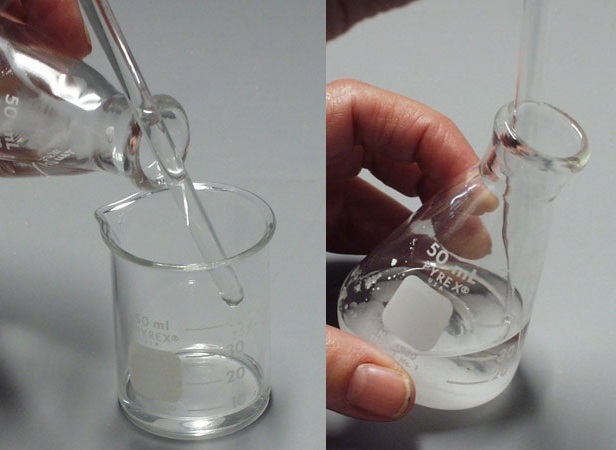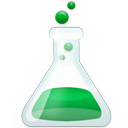Drying Organic Solutions
The process of synthesizing and isolating an organic compound often results in an organic compound or solution contaminated with traces of water. For instance, in aqueous extractions some water will be transferred into the organic phase because of the partial miscibility of the organic phase and water. Also, many reactions themselves are performed in an aqueous solution. This water must be removed before the required compound can be properly characterized.
In the Organic Chemistry Teaching labs at CU, two methods of drying solutions are commonly used: saturated aqueous sodium chloride and solid drying agents. These two methods are described below.
Saturated Aqueous Sodium Chloride
The bulk of the water can often be removed by shaking or "washing" the organic layer with saturated aqueous sodium chloride (otherwise known as brine). The salt water works to pull the water from the organic layer to the water layer. This is because the concentrated salt solution wants to become more dilute and because salts have a stronger attraction to water than to organic solvents.
To dry your organic product by this method, place the organic solution in a separatory funnel. The organic solvent can be any solvent that is immiscible with water. Add an amount of saturated aqueous sodium chloride, less than or equal to the amount of organic solution you have.

Stopper the funnel and shake as in an extraction. Allow the layers to separate. The rules as to which layer is on top are the same as for extraction. Since there is a lot of salt dissolved in the water, the density of the saturated aqueous sodium chloride solution is 1.2 g/mL. Drain off the lower layer. In this case, this is the organic layer and the layer you want to save. Dispose of the aqueous layer in the aqueous waste carboy. (In some cases, for instance if you are using diethyl ether, the upper layer will be the desired organic layer.)
Solid Drying Agents
Final traces of water are removed by treating the organic solution with a drying agent. A drying agent is an inorganic salt which readily takes up water to become hydrated. Several such salts are used routinely in the organic chemistry teaching labs:
| Drying Agent | Capacity | Speed | Applications |
| Calcium chloride, CaCl2 | High | Medium | Used for hydrocarbons |
| Calcium sulfate, CaSO4 (Drierite) | Low | Fast | Generally useful |
| Magnesium sulfate, MgSO4 | High | Fast | Not used for very acid-sensitive compounds |
| Potassium carbonate, K2CO3 | Medium | Medium | Not for acidic compounds |
| Sodium sulfate, Na2SO4 | High | Slow | Generally useful |
Of the five drying agents in the above table, magnesium sulfate is available as a fine powder and the rest are of a larger particle size. Calcium chloride, magnesium sulfate, and sodium sulfate are the three most commonly used agents. These are shown below.

Because these compounds will deliquesce (absorb moisture from the air), you MUST cap bottles of drying agents between uses! Otherwise, they will end up looking like the photo below.

When the Lab Manual tells you to "Dry over..." it refers to the process below. Usually, you will perform a wash with saturated sodium chloride solution to remove the bulk of the water before treating with an inorganic salt.
Add a small amount of the solid drying agent directly to the organic solution. Swirl the solution. Observe the drying agent; if it is all clumped together, add more. The pictures below show how a solution with drying agent looks when it is clumped and when it is free-flowing.

Each drying agent will have a slightly different appearance when clumped, and practice will make you better at judging whether or not the inorganic salt is wet or dry. There is no set rule as to how much drying agent needs to be added. The amount required depends on the amount of water in the solvent solution which you are drying, and this amount varies from experiment to experiment. Use as much as it takes to dry the solution. In most cases, drying is as complete as it will get in 20 minutes. When drying is complete, you need to remove the dried organic solution from the drying agent. There are several methods by which you can do this.
If the powder is quite fine (as when using magnesium sulfate) or if the volume is large, gravity filtration is the method of choice. If the drying agent is of larger particle size (as when using sodium sulfate or calcium chloride), decanting is the method of choice. An alternative to decanting is removing the liquid from the drying agent simply by drawing it off with a Pasteur pipet. Squeeze the bulb of the pipet, carefully place it flush with the bottom of the flask, and slowly draw liquid into the pipet, leaving the desiccant behind. Squirt the liquid into a fresh, clean flask. These two methods are shown below.

